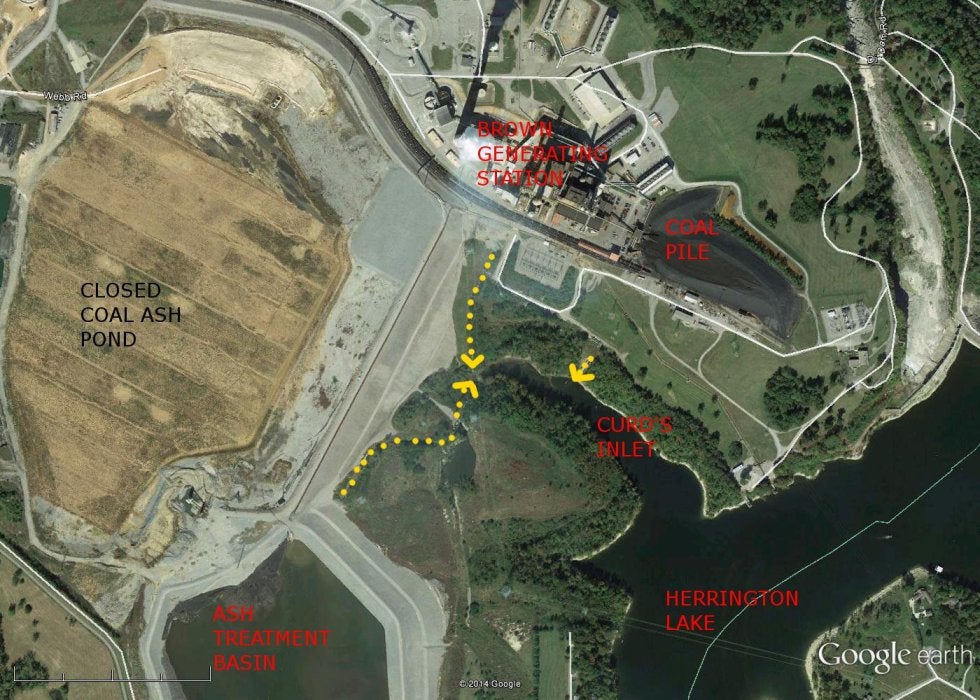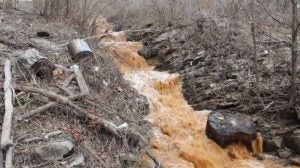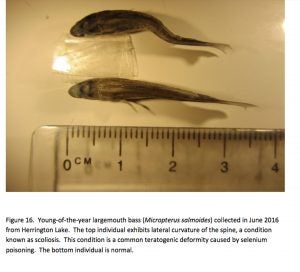Lawsuit over coal ash pond near Herrington Lake dismissed
Published 9:16 am Friday, January 5, 2018

- An edited aerial photo shows the size of the closed coal ash pond behind the E.W. Brown Generating Station on Herrington Lake in Mercer County. (Kentucky Waterways Alliance)
Federal judge says case should be dealt with at state level; ruling does not address pollution concerns
Editor’s note: Check back in the weekend edition for more information from the state about the next step in the Corrective Action Plan.
In an action many residents and other involved parties are calling “unsurprising,” a federal judge in Lexington has dismissed the case against Kentucky Utilities over pollution seeping into Herrington Lake.
U.S. District Judge Danny Reeves ruled his court has no authority over the case filed in October, brought against the utilities company in a suit by EarthJustice, a non-profit organization with the backing of the Sierra Club and Kentucky Waterways Alliance.
EarthJustice attorney Thomas Cmar says the suit was filed under the basis of two federal acts: The Federal Clean Water Act and The Resource Conservation and Recovery Act.
“The Clean Water Act governs the discharges of wastewater, or dumping of wastewater, and RCRA requires companies to clean up their pollution and ensure those risks are abated,” Cmar said.
The ruling states that “Congress determined that regulation of groundwater should be left to the states.”
“Congress did not intend for the Clean Water Act to extend federal regulatory authority over groundwater, regardless of whether that groundwater is eventually or hydrologically connected to navigable surface waters,” the ruling reads. “… As a result, the plaintiff’s allegations are insufficient to state a claim for the unlawful discharge of a pollutant …”
There are 6 million cubic yards of coal ash buried behind E.W. Brown Generating Station, located just outside of Harrodsburg in Mercer County. The suit asks the power plant — operated by KU Energy and owned by Louisville Gas & Electric, a subsidiary of PPL Corporation out of Louisville — to take responsibility for the high amounts of toxins, including selenium, arsenic, boron and other pollutants, leaching out into the water source and affecting fish. Tests by the Kentucky Division of Water found fish near the plant had arsenic levels 98 times higher than the amount allowed by Kentucky water standards.
Cmar said discussions are still being conducted internally with the Sierra Club and Kentucky Waterways Alliance on whether they will file an appeal in the Sixth Circuit U.S. Court of Appeals in Cincinnati.
“We are disappointed, and feel like the legal grounds on which the court relied upon are a very narrow reading of those laws,” Cmar said. “It’s very important to note that the court’s decision doesn’t address the merit of the case; it doesn’t address whether or not it’s in fact polluting Herrington Lake.”
Cmar said KU asked the court to rule on technical, legal grounds that federal court wasn’t the right place for the ruling, due to the state agencies involved and a study plan the utilities company submitted.
“It’s called a ‘corrective action plan,’ but contains no plan other than studying it for several more years,” he said. “It’s not nearly effective enough to address the pollution that’s already been identified.”
Cmar said the whole reason the suit was brought to federal court was due to the years’ worth of time spent already on this issue, with no action. EarthJustice and its backers have met with the state and the utility company over the years — since 2013, when KU first said it would be creating a landfill on top of the existing 6 million cubic yards of coal ash.

Kentucky Division of Waste Management (DWM) had employees on a site visit on Feb. 20, 2014. On the site visit, they recorded a video of a discharge occurring and noted a number of other hydrogeologically significant features and contaminated areas. (Photo courtesy of the Kentucky Waterways Alliance)
“For over four years, we’ve been trying to have this kind of conversation with the state and the company, about what could be done to rectify the problem, and we’ve not been able to have it. The company has not yet acknowledged that is has a responsibility to clean up Herrington Lake. That’s the core at why we haven’t been able to make progress.”
Cmar says this decision underscores the role that Kentucky state agencies have in such issues.
“The ball is very much in the state’s court, the Division of Water’s court, to take a hard look at the growing evidence in front of them. This is a growing problem and it’s not going away. We’re going to keep calling on the state.”
First and foremost, Cmar said, a public hearing or meeting of some kind for local residents must be held. It’s their right, he said, to get information about the issue and be able to raise concerns and have their voices heard by the state and the utility company. More than a dozen residents have already written the state and asked for such a meeting, and the state has not responded to their requests.
“None of our legal efforts would be necessary if the state would do its job and force the company to come to the table with a real plan to actually clean up the lake,” Cmar said. He said the groups involved intend to renew their call for the Division of Water to hold a public meeting. “And we intend to keep pushing in every forum available to us for an effective cleanup that will ensure a healthy Herrington Lake for generations to come.”
“We think we’re in compliance,” has been the ongoing statement put forward by KU, as said again this week by spokesperson Chris Whelan. She said the judge has issued a “well-reasoned response,” and the company is continuing to follow the plan it submitted to the state. And an aquatic study has begun.
“We’re continuing to work on it. We did some fish testing in the fall and will continue that into the first quarter. We’re continuing to do our part of the remediation plan … We’re continuing the monitoring. That’s part of the plan, and everything is fully regulated.”
When Whelan was asked about the findings by Dr. Dennis Lemly — a fishery research biologist who’s studied and had published findings on coal ash for 40 years — she said his report was inconsistent with other findings.

A photo and explanation of evidence, submitted by Dr. Dennis Lemly on behalf of the plaintiffs suing Kentucky Utilities over pollution in Herrington Lake.
Lemly’s report showed photographs of fish taken from the area with birth defects such as crooked spines and deformed mouths.
“The Department of Fish and Wildlife, they didn’t find any deformities. Lemly’s is very inconsistent, the ruling of the case shows it was dismissed in its entirety. The water testing has shown there’s no danger to the fish — the Kentucky Department of Fish and Wildlife said so. And the fact the water quality is in compliance.”
Whelan went on to say, “The conclusions he drew were so inconsistent, it’s legal posturing. We are very concerned with what the report came up with. There’s no supporting data that we’ve seen. We’ve asked for it, and so has the state.”
“I don’t know what Ms. Whelan is referring to by ‘Fish and Wildlife,’” Cmar responded. “When the Division of Water tested fish samples in May of 2016, it found nine out of 10 had levels of selenium in their bodies in excess of state water quality standards.”
Cmar said Whelan is incorrect when she says they haven’t responded to the state’s request for more information.
He said after Lemly’s findings and testimony were filed with the court in October, the state Division of Water requested several categories of additional information — including the sampling data and more detail about the methods used.
“It took us several weeks to collect all of the information and we sent it to the state. We also sent a courtesy copy to KU, so they now have all of this information, although apparently it has not yet been shared with Ms. Whelan.”
Cmar said Lemly’s findings are based off of his 40 years of peer-reviewed research and methods, and adds his recent findings on Herrington Lake were accepted and published by a prominent international scientific journal after peer review by other leading experts in the field.
“This is how the scientific method works, and it is deeply disheartening to hear KU attack scientists because it doesn’t want to accept responsibility for its own actions,” he said.
Lemly agreed.
A private consultant in this case, Lemly retired in 2016 after working for the federal government in Fish and Wildlife, and for the U.S. Forest Service.
“I stand on my published study that was endorsed and confirmed for its scientific credibility … If they deny or impune its credibility and implication for E.W. Brown Generating Station and Herrington Lake, then the state of Kentucky and the courts are clearly under regulatory capture by the electric utility,” Lemly said.
Lemly said he will repeat his motto, what he said during his first-ever court case he testified in.
“I was asked, ‘Dr. Lemly, who do you represent?’ I said, ‘I represent fish and wildlife, not people, not industry, not government.’ Credible, peer-reviewed science should control the outcome and proper solution of this coal ash water pollution issue in the lake for the benefit of fish and wildlife and the public, not me — not Kentucky Utilities, not the state of Kentucky, not the courts.”
Lemly said he is not a “hired gun.”
“Not as KU and others would have you and others believe. This is not a trivial matter for me, fish and wildlife, or the public. I’ve been in it for 40 years. It goes to the core issue of coal ash disposal, aquatic pollution, rampant killing of fish and wildlife, threats to human health, and what we do about it as a society when faced with powerful industry intervention that negates prudent and proper regulatory controls.”






